Papilio troilus
The Spicebush Swallowtail (Papilio troilus) is a fascinating butterfly known for its large, black wings marked with light blue and green spots and distinctive orange spots on the hindwings. It is not currently listed as threatened or endangered, but like many species, it is affected by habitat loss and environmental changes.
Spicebush Swallowtail butterflies are primarily found in the Eastern United States, from New England down to Florida and westward to the Great Plains. They inhabit deciduous woodlands, fields, gardens, and along edges of streams and rivers, favoring areas where spicebush and sassafras, their primary caterpillar host plants, grow.
You can also find them in suburban areas and parks, wherever these host plants are present. Their range extends into parts of the Midwest and can sometimes be seen as far west as Texas. They are more common in the southeastern states, where their host plants are abundant.
The Spicebush Swallowtail butterfly is distinguished by its unique and attractive physical appearance, which includes several key features:
This combination of striking colors and patterns not only makes the Spicebush Swallowtail visually appealing but also serves as a defense mechanism against predators, blending into the shadows of foliage or mimicking less palatable butterfly species.
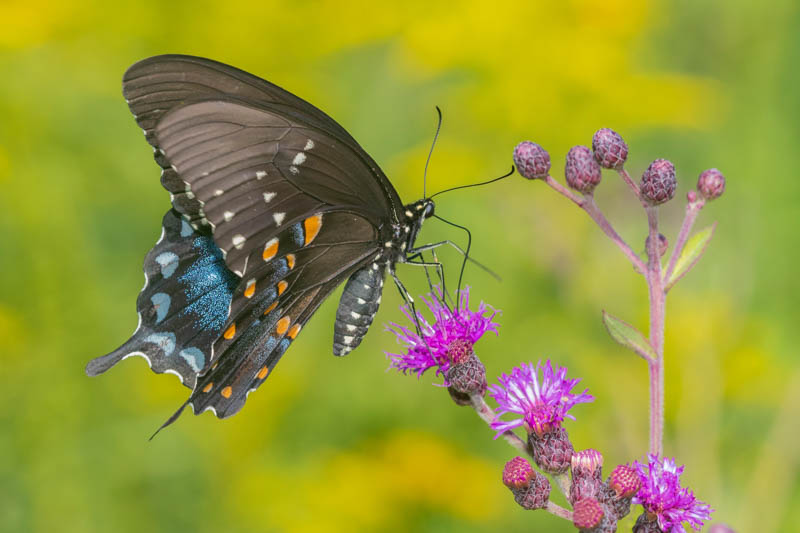 Spicebush Swallowtail (Papilio troilus) on Missouri Ironweed (Vernonia missurica)
Spicebush Swallowtail (Papilio troilus) on Missouri Ironweed (Vernonia missurica)
The courtship and mating behavior of the Spicebush Swallowtail butterfly is a fascinating and complex process characterized by specific rituals and behaviors:
Courtship Flight: The male Spicebush Swallowtail often engages in a courtship flight, which involves flying in a specific pattern around the female. This can include flying in circles above her or fluttering near her to display his iridescent wing colors.
Pheromone Release: Male butterflies release pheromones to attract females. These chemical signals are an important part of the courtship process, helping the male to attract a mate.
Perching and Patrolling: Males typically exhibit two types of behavior to find females – perching and patrolling. Perching involves waiting in a spot often sunny to intercept passing females. Patrolling is a more active approach, where the male flies through habitats searching for females.
Tactile Interaction: Once a male has found a potential mate, he will engage in tactile interaction, touching her with his legs or antennae. This physical contact is part of the courtship ritual and helps to stimulate the female.
Mating: If the female is receptive, mating will occur. The pair will typically remain joined end to end for some time during the mating process, which can last several hours.
Role of Host Plants: The availability of host plants like spicebush and sassafras can play a significant role in the mating process, as females often choose to lay eggs on these plants after mating. Hence, males may patrol areas where these plants are abundant.
Single or Multiple Mating: Female Spicebush Swallowtails may mate multiple times during their lifespan, which can influence egg-laying and the genetic diversity of the offspring.
Post-Mating Behavior: After mating, females focus on finding suitable host plants to lay their eggs, while males may continue to search for additional mates.
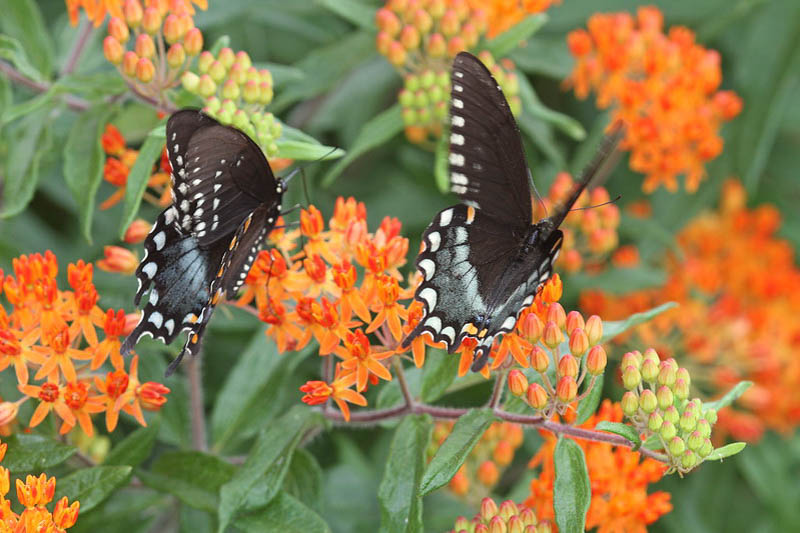 Spicebush butterflies on Milkweed (Asclepias)
Spicebush butterflies on Milkweed (Asclepias)
Like other butterflies, the life cycle of the Spicebush Swallowtail butterfly consists of four distinct stages: egg, caterpillar (larva), pupa (chrysalis), and adult butterfly. This process, known as complete metamorphosis, is a fascinating transformation.
Egg Stage: The life cycle begins when a female lays her eggs on the underside of leaves, particularly favoring spicebush and sassafras plants. The eggs are tiny and spherical, usually greenish-white.
Caterpillar Stage: The caterpillar (larva) emerges once the eggs hatch. The caterpillars are unique for their ability to mimic bird droppings in their early stages, which helps protect them from predators. As they grow, they become green with false eye spots, resembling a snake’s head, another defense mechanism. The caterpillars feed voraciously on the leaves of their host plants, shedding their skin several times as they grow.
Pupa Stage: After reaching a certain size, the caterpillar finds a suitable spot to form a chrysalis. This stage is where the most dramatic transformation occurs. The chrysalis is typically brown or green, blending in with the surrounding environment. Inside, the caterpillar undergoes metamorphosis, developing wings and other adult structures.
Adult Butterfly Stage: Finally, the adult Spicebush Swallowtail emerges from the chrysalis. It will spend some time pumping fluids into its wings to expand them. Once its wings are dry and fully expanded, the butterfly is ready to fly, feed on nectar, and begin the process of finding a mate to start the life cycle anew.
The entire process from egg to adult butterfly varies in length, depending on environmental conditions like temperature and humidity, but typically takes about a month. The Spicebush Swallowtail can have multiple generations in a year, especially in warmer climates.
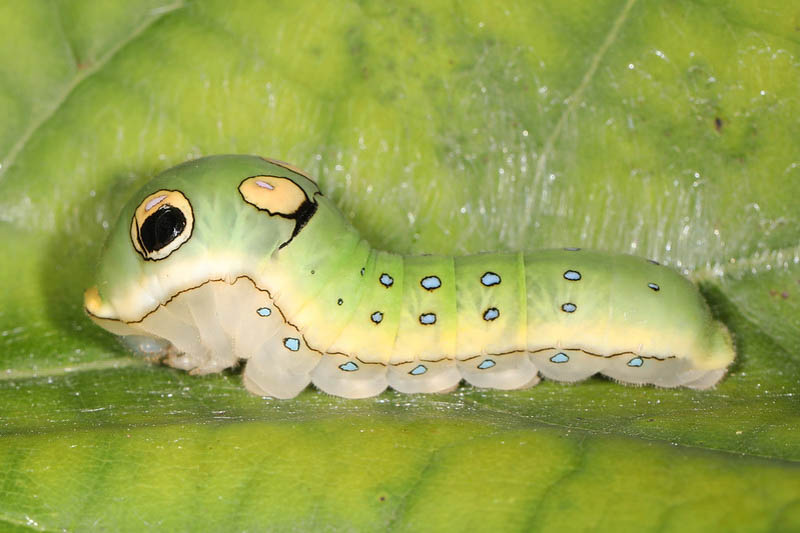 Spicebush Swallowtail Caterpillar
Spicebush Swallowtail Caterpillar
The diet of the Spicebush Swallowtail butterfly varies throughout its life cycle:
Caterpillar Stage: In the larval stage, Spicebush Swallowtail caterpillars feed exclusively on the leaves of their host plants. Spicebush (Lindera benzoin) and sassafras (Sassafras albidum) are the primary host plants. They may also feed on other plants, including prickly ash (Zanthoxylum americanum), tulip tree (Liriodendron tulipifera), sweetbay (Magnolia virginiana), camphor (Cinnamomum camphora), and redbay (Persea borbonia).
Adult Butterfly Stage: Once they emerge as adult butterflies, their diet changes to nectar from a variety of flowering plants. Adult Spicebush Swallowtails are frequent visitors to gardens and wildflowers, where they feed on nectar from flowers like milkweed, Japanese honeysuckle, jewelweed, thistles, azalea, dogbane, lantana, mimosa, and sweet pepperbush. The nectar gives them energy for flying, mating, and laying eggs.
In both stages, the choice of food is crucial for their survival. As caterpillars, the host plants provide nourishment, habitat, and protection. As adults, the nectar from various flowers provides the necessary nutrients and energy to sustain their activities and reproductive processes.
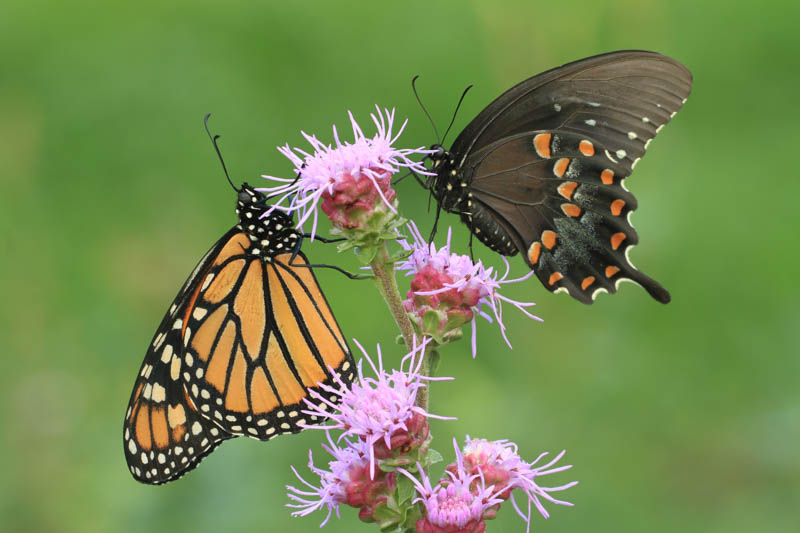 Monarch butterfly and spicebush swallowtail butterfly on rough blazing star liatris
Monarch butterfly and spicebush swallowtail butterfly on rough blazing star liatris
The Spicebush Swallowtail butterfly, known for its distinctive flight and migratory behavior, exhibits several key characteristics in these aspects:
Flight Pattern: Spicebush Swallowtails are strong and agile fliers. Their flight is typically characterized by a series of rapid wing beats followed by glides. This fluttering and gliding pattern allows them to navigate effectively through their habitat, including dense woodlands and open areas.
Territorial Behavior: Male Spicebush Swallowtails often exhibit territorial behavior, especially during mating season. They may choose a specific area to patrol and defend against other males, usually a sunlit spot that also attracts females.
Migration: Unlike other butterfly species, such as the Monarch butterfly, Spicebush Swallowtails do not migrate long-distance. However, they may move locally in response to changes in weather or the availability of host plants and nectar sources. These movements are typically within a relatively limited range.
Overwintering: In regions with colder winters, Spicebush Swallowtail caterpillars overwinter in diapause (hibernation) as pupae. They form a chrysalis that blends in with the surrounding vegetation and remains dormant until the conditions are favorable in spring.
Like many butterfly species, the Spicebush Swallowtail butterfly faces various predators throughout its life cycle, from the caterpillar stage to the adult butterfly stage. These predators include:
Birds: Birds are primary predators of Spicebush Swallowtail butterflies, especially in the adult stage. The bright colors of the butterflies can attract birds. Still, their coloration and patterns also serve as a defense mechanism, either by mimicking less palatable species or warning of potential toxicity.
Spiders: Spiders can capture Spicebush Swallowtails in their webs. This is more common for adult butterflies, as caterpillars are less likely to encounter spiderwebs due to their habitat preferences.
Parasitic Wasps and Flies: Spicebush Swallowtails are vulnerable to parasitic wasps and flies in the caterpillar stage. These parasites lay eggs on or in the caterpillars, and the emerging larvae feed on the caterpillar, often leading to its death.
Small Mammals: Small mammals, including rodents like mice and squirrels, may prey on Spicebush Swallowtail caterpillars and pupae. These mammals can be opportunistic feeders and may consume the caterpillars or chrysalises if they come across them.
Amphibians and Reptiles: Frogs, toads, and lizards can also be predators of Spicebush Swallowtail butterflies, particularly in regions where these amphibians and reptiles are common.
Insect Predators: Other insects, such as ants and larger predatory beetles, can prey on the eggs and young caterpillars of the Spicebush Swallowtail.
The Spicebush Swallowtail has developed various defensive strategies to reduce predation risks. For example, the caterpillars have a snake-like appearance to deter birds and other predators, and the adult butterflies’ coloration can mimic less palatable or toxic species. Despite these defenses, predation is a natural part of their life cycle and plays a role in the ecosystem dynamics.
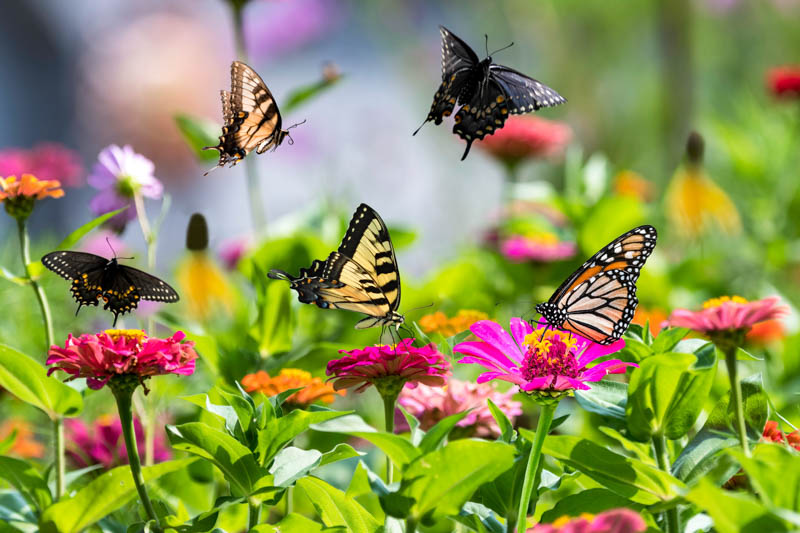
Attracting Spicebush Swallowtail butterflies to your garden and creating a butterfly haven requires a combination of specific host plants for their caterpillars and nectar sources for the adults. Here are some key steps to create an inviting habitat for these beautiful butterflies:
Plant Host Trees and Shrubs: Since Spicebush Swallowtail caterpillars feed on spicebush (Lindera benzoin) and sassafras (Sassafras albidum), planting these is crucial. Including these plants in your garden provides a food source for the caterpillars and encourages the butterflies to lay eggs.
Provide Nectar-Rich Flowers: Adult Spicebush Swallowtails feed on nectar from a variety of flowers. Include plants such as milkweed, Japanese honeysuckle, jewelweed, thistles, azalea, dogbane, lantana, mimosa, and sweet pepperbush in your garden. Diverse flowering plants that bloom at different times during the growing season ensure a continuous nectar supply.
Sunny and Sheltered Spots: Butterflies prefer sunny locations sheltered by strong winds. Choose a spot in your garden that receives plenty of sunlight but is also protected.
Water Source: Include a shallow water source, like a birdbath or a puddle area, where butterflies can drink and extract minerals. A damp patch of sand or soil can serve as a puddling spot for them.
Avoid Pesticides: Pesticides can be harmful to butterflies and caterpillars. Use organic gardening practices and avoid chemical pesticides to ensure a safe environment for the butterflies.
Natural Habitat Elements: Incorporating elements of their natural habitat, like leaf litter and logs, can provide hiding spots for caterpillars and pupae.
Gardening Practices: Practice butterfly-friendly gardening by allowing a little wildness. For instance, not deadheading all flowers provides seeds for birds and allows some plants to naturally reseed.
Learning and Observation: Educate yourself about the life cycle and needs of the Spicebush Swallowtail to better cater to their specific requirements. Observing your garden and the butterflies’ behavior can also provide insights into their preferences and needs.
By creating a habitat that caters to both the caterpillars and adult butterflies, your garden can become a haven for the Spicebush Swallowtail, enhancing both the health of your local ecosystem and your enjoyment of these beautiful creatures.
Create a membership account to save your garden designs and to view them on any device.
Becoming a contributing member of Gardenia is easy and can be done in just a few minutes. If you provide us with your name, email address and the payment of a modest $25 annual membership fee, you will become a full member, enabling you to design and save up to 25 of your garden design ideas.
Join now and start creating your dream garden!
Create a membership account to save your garden designs and to view them on any device.
Becoming a contributing member of Gardenia is easy and can be done in just a few minutes. If you provide us with your name, email address and the payment of a modest $25 annual membership fee, you will become a full member, enabling you to design and save up to 25 of your garden design ideas.
Join now and start creating your dream garden!